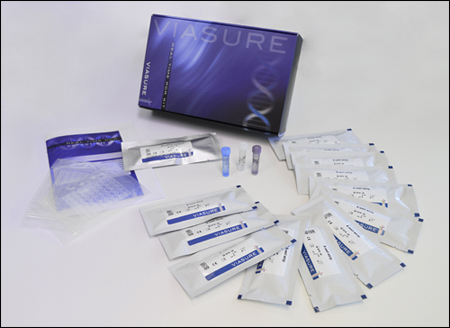
VIASURE Real Time PCR Detection Kits
Salmonella, Campylobacter & Y. enterocolitica

Description
VIASURE Salmonella, Campylobacter & Y. enterocolitica Real Time PCR Detection Kit is designed for specific detection and differentiation of Salmonella, Campylobacter and Yersinia enterocolitica in human stool samples from patients with signs and symptoms of gastrointestinal infection.
This test is intended for use as an aid in the diagnosis of the Salmonella, Campylobacter and/or Yersinia enterocolitica in combination with clinical and epidemiological risk factors.
DNA is extracted from stool specimens, multiplied using Real Time amplification and detected using specific primers and a fluorescent reporter dye probe for Salmonella, Campylobacter and/or Yersinia enterocolitica.
Specifications
Information
The Salmonella genus is divided taxonomically into six Salmonella enterica subspecies and Salmonella bongori. Salmonella causes two types of diseases: enteric (typhoid) fever and acute gastroenteritis commonly referred to as salmonellosis.
Transmission of Salmonella occurs through contaminated food (poultry, poultry products, beef, pork, eggs, milk, and seafood), water or contact with infected animals. Patients infected with Salmonella frequently suffer nausea, vomiting, abdominal cramps/pains, achiness, fever, intense diarrhea and/or headache.
The Campylobacter genus consists of 26 species, 2 provisional species, and 9 subspecies. The most common species of Campylobacter associated with human illness are C. jejuni and C. coli, but other species can also cause human infections. Poultry is a major reservoir and source of transmission of Campylobacter to humans. Other risk factors include consumption of animal products and water, contact with animals, and even person-to-person transmission (fecal-oral or via fomites). Infection with Campylobacter causes gastroenteritis characterised by fever, vomiting, headaches, and abdominal pain with watery or bloody diarrhea, for a median duration of 6 days.
The genus Yersinia has three well known human and animal pathogens: Yersinia enterocolitica, pestis and pseudotuberculosis. There are six biotypes of Y. enterocolitica; five of which are considered pathogenic in humans (biotypes 1B, 2, 3, 4 and 5). In addition, there are 60-70 serotypes, among which O:3, O:9, O:8, O:5,27 are mainly associated with human disease. Yersinia enterocolitica is a foodborne pathogen and its clinical manifestations typically include nausea, vomiting, abdominal pain, diarrhea and fever. There is a strong evidence that the food of animal origin especially pork and dairy products are responsible for human infections.
Target genes most frequently employed for rapid detection and identification of Salmonella, Campylobacter and Yersinia enterocolitica using Real Time PCR assays are the virulence invA gene (Salmonella invasion protein gene), 16S rRNA gene and ail (attachment-invasion locus) gene, respectively.

